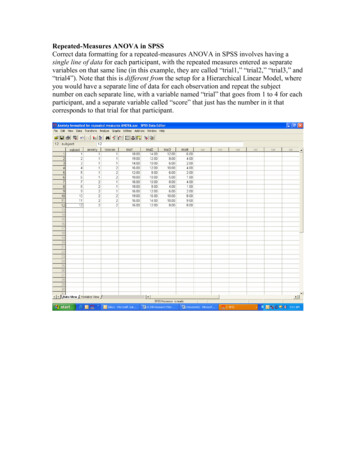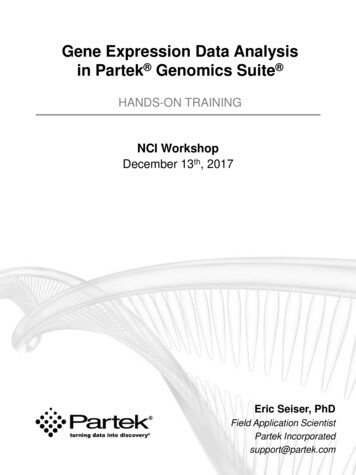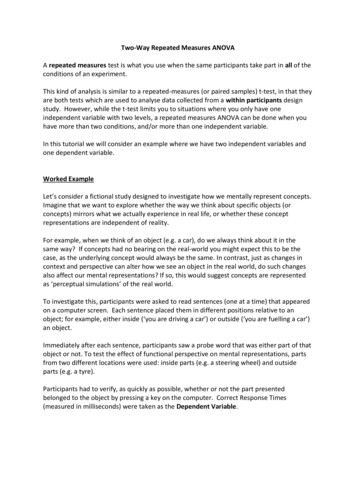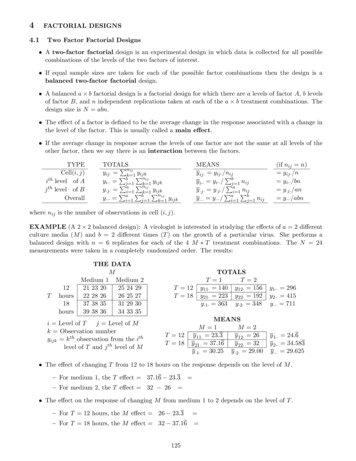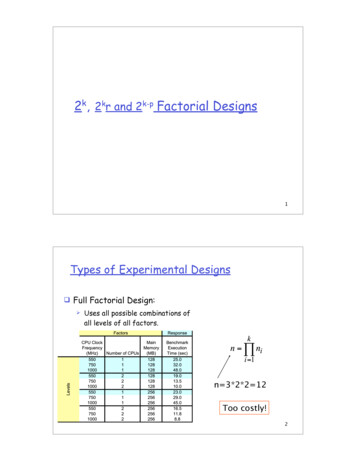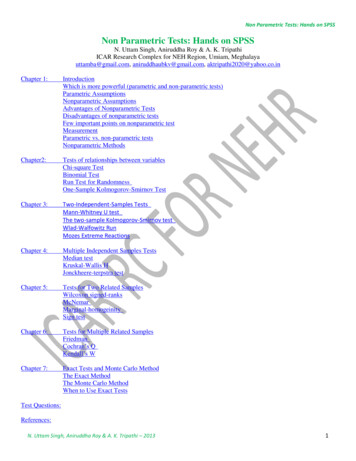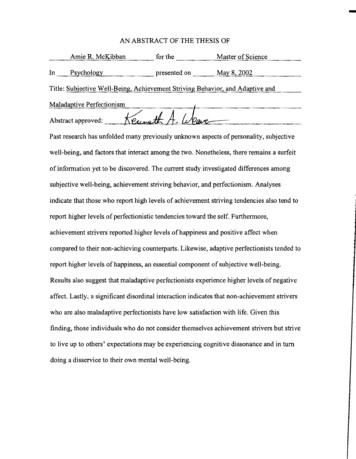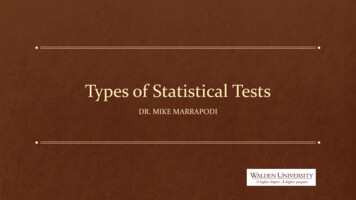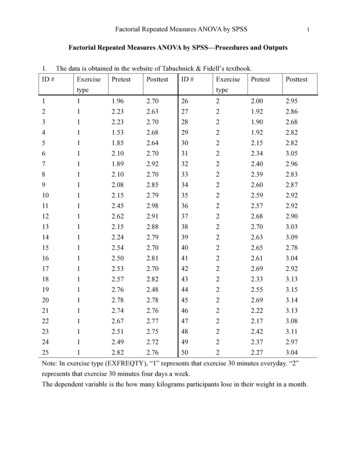
Transcription
Factorial Repeated Measures ANOVA by SPSS1Factorial Repeated Measures ANOVA by SPSS—Procedures and Outputs1.The data is obtained in the website of Tabachnick & Fidell’s textbook.ID #ExercisetypePretestPosttestID .133.083.112.973.04Note: In exercise type (EXFREQTY), “1” represents that exercise 30 minutes everyday. “2”represents that exercise 30 minutes four days a week.The dependent variable is the how many kilograms participants lose in their weight in a month.
Factorial Repeated Measures ANOVA by SPSS22.Participants who involve in a dieting program to lose their weight are recruited to examinewhether there is a statistical significant difference between two kinds of exercise frequencyin determination of the weight loss. Fifty participants are recruited and randomly assignedinto two groups. In Group 1, participants will exercise 30 minutes everyday. In Group 2,participants will exercise 30 minutes for four days per week. Prior to beginning the exercise,pretest is conducted to see how many kilograms participants lose in their weight by dietingin a month. Then participants engage in aerobic exercise for a month. Posttest is conductedto see how many kilograms participants lose after they involve in exercise.3.Before running Factorial Repeated Measures ANOVA, model assumptions must be tested.Normality will be tested first.Click “Analyze”, then “Descriptive Statistics,” and then “Explore” to examine the normality.
Factorial Repeated Measures ANOVA by SPSS4.Move the between-subjects variable (EXFREQTY –two kinds of exercise frequency) into“Factor List,” and the within-subject variables (TESTTIME -pretest and posttest) into“Dependent List”.3
Factorial Repeated Measures ANOVA by SPSS5.Then click on “Plot”, check the “normality plots with tests.” Then click “continue” and“OK.”4
Factorial Repeated Measures ANOVA by SPSS6.5Reading output of Normality (Refer to page 3 in the output.)With moderate sample size of 50 people, the Shapiro-Wilk test for normality is examined atsignificant value of .01. The significant values of both pretest and posttest of these twokinds of exercise frequency are greater than .01. The sample is not significantly deviatedfrom normality. Then we can examine the Homogeneity of Covariance by examine theBox’s Test.
Factorial Repeated Measures ANOVA by SPSS7. Running Factorial Repeated Measures ANOVA by SPSSClick “Analyze,” then “General Linear Model,” and then “Repeated Measures.”6
Factorial Repeated Measures ANOVA by SPSS8.Name the Within-Subject variable by putting the name into the “Within-Subject FactorName.” Then put the number of levels of Within-subject variable into the “Number ofLevels.” In this case, the number of level will be 2, since there is only one pretest and oneposttest.7
Factorial Repeated Measures ANOVA by SPSS9.Then click “Add,” and then click “Define.”8
Factorial Repeated Measures ANOVA by SPSS10. Move the Between-Subjects variable (EXFREQTY –the exercise frequency) from the leftbox to the “Between-Subject Factor(s)” box on the right. Then move the Within-Subjectsvariables (TESTTIME -pretest and posttest) from the left box to the “Within-SubjectsVariable” box on the right. Then click “Options.”9
Factorial Repeated Measures ANOVA by SPSS11. Move the Factors and Factor interactions from the left box to the right box of “DisplayMeans for.” Then check “Descriptive Statistics,” and “Homogeneity tests.” Then click“continue.”10
Factorial Repeated Measures ANOVA by SPSS12. Reading output for Homogeneity of Covariance. (Refer to page 10 in the output.)In the results of Box’s Test of Equality of Covariance Matrices. The result is tested at thesignificant value of .01. Therefore, the covariance is homogeneous.11
Factorial Repeated Measures ANOVA by SPSS13. Refer to page 11 in the output.After the model assumptions are evaluated and met, examine whether there is interactioneffect first. In the results of “Tests of Within-Subjects Contrasts,” the result of“TESTTIME*EXFREQTY” is not significant, F (1, 48) 3.43, p .07. There is nointeraction effect. Then we will examine the main effect. The result of main effect ofTESTTIME is significant, F (1, 48) 132.59, p .001.12
Factorial Repeated Measures ANOVA by SPSS1314. Refer to page 11 in the output.Then we are going to examine another main effect of EXFREQTY. In the box of “Test ofBetween-Subjects Effect.” There is significant main effect in EXFREQTY, F (1, 48) 7.35,p .009.
Factorial Repeated Measures ANOVA by SPSS15. To plot—Click “Plots.” Move the Between-Subjects Variable (EXFREQTY –exercisefrequency type) from the left box to the right box of “Horizontal Axis,” and theWithin-Subjects Variable (TESTTIME -pretest and posttest) from the left box to the rightbox of “Separate Lines.” Then click “Add,” then “Continue,” and then “OK.”14
Factorial Repeated Measures ANOVA by SPSS16. We can also examine the plot of the results to help us easily see the pattern of the results.15
Factorial Repeated Measures ANOVA by SPSS16ResultsA two-way ANOVA with repeated measure on one factor was conducted to determinewhether there was a statistical significance between two different types of exercise frequency forhelping losing weight. The independent variable included a between-subjects variable, theexercise frequency, and within-subject variable, repeated measures of pretest and posttest. Thedependent variable was the amount of kilograms of weights loss in a month. An alpha levelof .05 was utilized for this analysis. Results for model assumptions of normality, homogeneity ofcovariance, and linearity were satisfactory.There was not a statistically significant interaction in the amount of weight loss betweenthe exercise frequency type and test time, F (1, 48) 3.43, p .07. The result of main effect ofpretest and posttest was significant, F (1, 48) 132.59, p .001, η2 .73. A large effect size wasevident. There was also a significant main effect in the exercise frequency type, F (1, 48) 7.35,p .009, η2 .13, which was indicative of a moderate to large effect size.
Factorial Repeated Measures ANOVA by SPSS 1 Factorial Repeated Measures ANOVA by SPSS—Procedures and Outputs 1. The data is obtained in the website of Tabachnick & Fidell's textbook. ID # Exercise type Pretest Posttest ID # Exercise type Pretest Posttest 1 1 1.96 2.70 26 2 2.00 2.95 2 1 2.23 2.63 27 2 1.92 2.86
